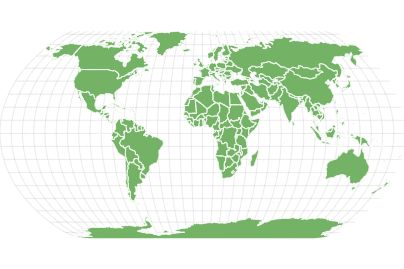Elephant Seal
Mirounga
The largest species of seal in the world!
Advertisement
Elephant Seal Scientific Classification
- Kingdom
- Animalia
- Phylum
- Chordata
- Class
- Mammalia
- Order
- Carnivora
- Family
- Phocidae
- Genus
- Mirounga
- Scientific Name
- Mirounga
Read our Complete Guide to Classification of Animals.
Elephant Seal Conservation Status
Elephant Seal Facts
- Main Prey
- Fish, Squid, Octopus
- Distinctive Feature
- Long trunk-like nose and large body
- Habitat
- Warm coastal waters close to land
- Predators
- Human, Sharks, Killer Whales
- Diet
- Carnivore
- Average Litter Size
- 1
- Lifestyle
- Herd
- Favorite Food
- Fish
- Type
- Mammal
- Slogan
- The largest species of seal in the world!
View all of the Elephant Seal images!
Elephant seals can dive more than 5,000 feet into the ocean and can hold their breath for two hours.
The trunk-like nose of this seal makes it easy to see how it got its name. The average lifespan of a northern elephant seal is nine years while an elephant seal living in the Antarctic region can live from 20 to 22 years. Male seals can weigh up to 4.5 tons. They are carnivores living on a diet of squid, fish, rays, penguins, and some small species of sharks.
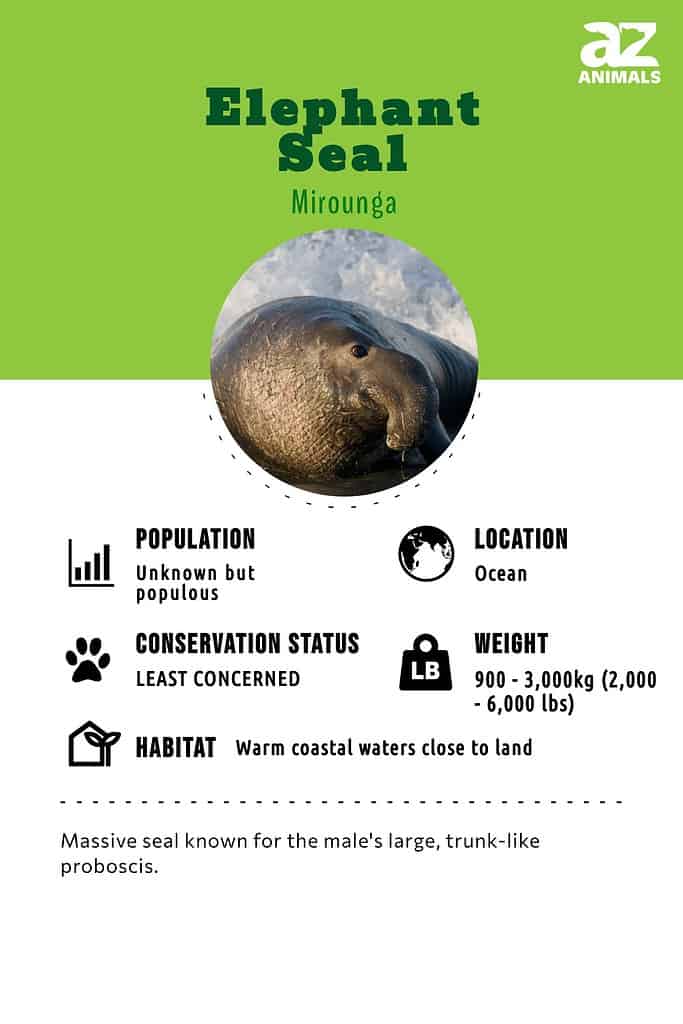
5 Elephant Seal Facts
• These seals spend approximately nine months of the year in the water.
• They are excellent swimmers but move awkwardly while on land.
• Male elephant seals are called bulls.
• These seals were hunted in the 19th century until they were almost extinct.
• An elephant seal becomes an adult at three years of age.
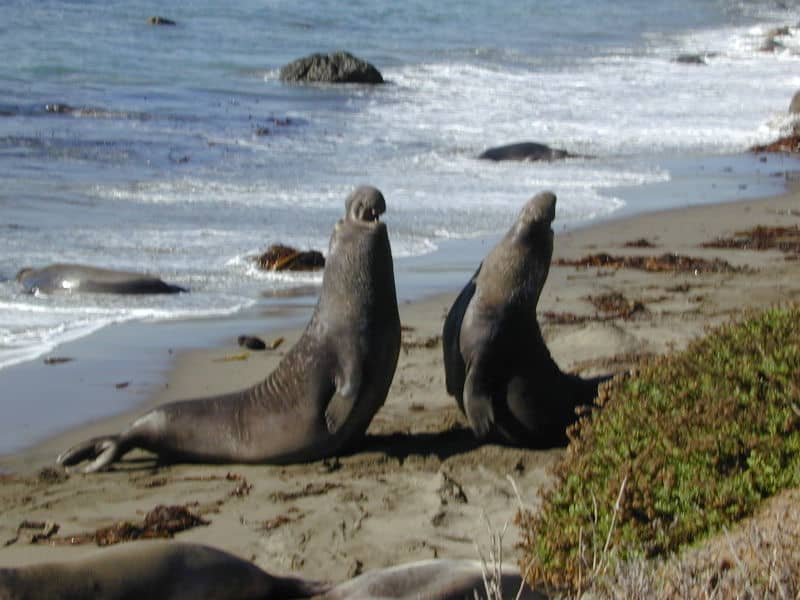
Northern elephant seals can be seen in California, Mexico the Aleutian Islands, and the Gulf of Alaska.
Scientific Name and Species
The scientific name for these seals is Mirounga. Mirounga, or ‘miouroung,’ is an Australian aboriginal word meaning seal. The elephant seal belongs to the Phocidae family and the class Mammalia.
There are two species of elephant seal:
- Northern Elephant Seals (Mirounga angustirostris), can be found in the North Pacific near Baja California, Mexico, the Aleutian Islands, and the Gulf of Alaska.
- Southern Elephant Seals (Mirounga leonina), can be found in sub-Antarctic and Antarctic waters.
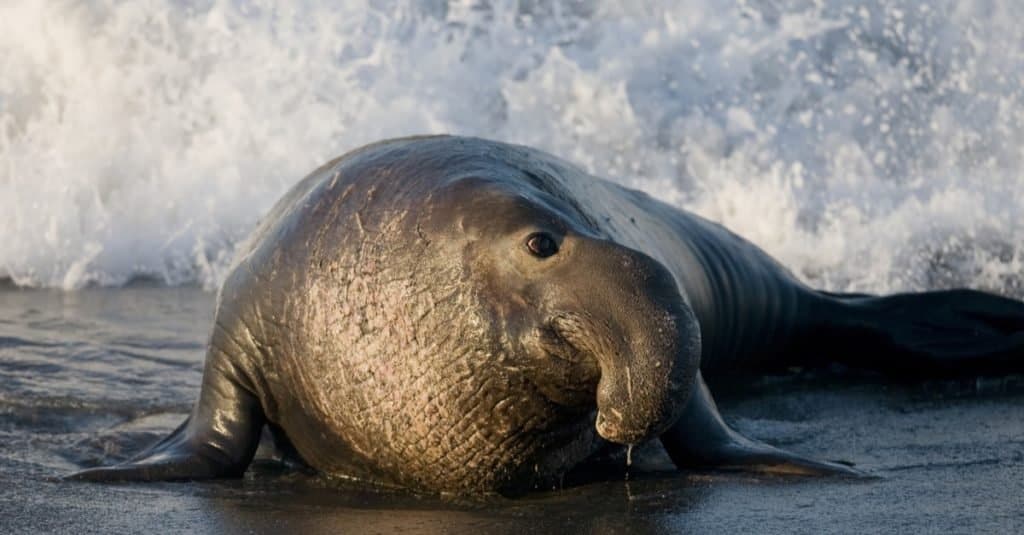
Elephant Seals are pinnipeds that are believed to have evolved from land mammals like otters.
©creativex/Shutterstock.com
Evolution
Information about the evolution of elephant seals is spotty, however, they are pinnipeds, or, marine animals with flippers. Pinnipeds are believed to have evolved from land animals like otters or bears. (The skulls of elephant seals are very similar to the skulls of bears.) According to fossil records, pinnipeds appeared in the oceans around 25 million years ago – about 25 million years after the appearance of whales. The early pinnipeds dwelled in shallow waters and had well-developed flippers and teeth that indicate that they chewed their food like land animals. Elephant seals have since evolved to swallow food whole.
Appearance and Behavior
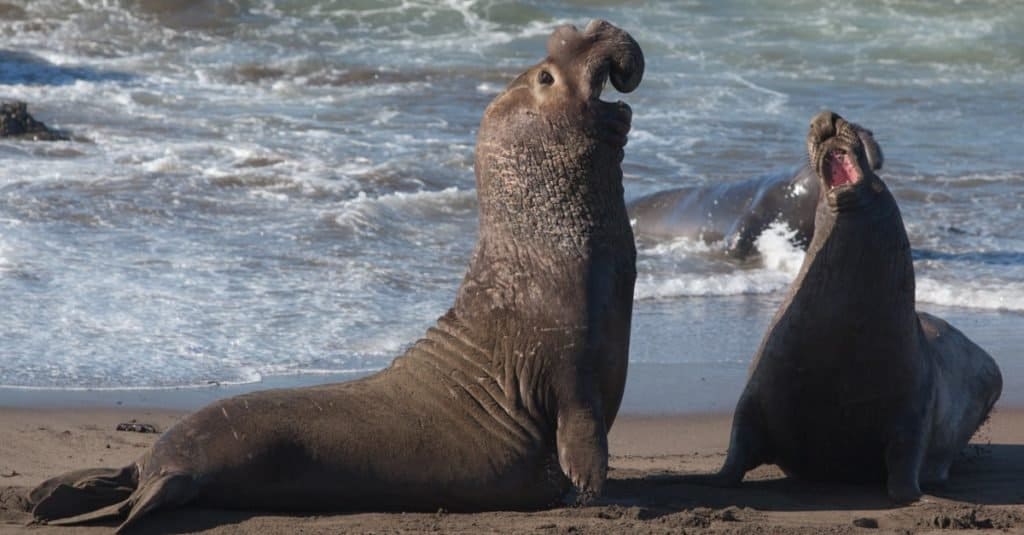
Male elephant seals fight during mating season.
©FiledIMAGE/Shutterstock.com
These seals are covered in a layer of light or dark tan or grayish fur. While male seals have a large trunk-like nose, also called a proboscis, female seals have a nose that’s normal in size. These seals have large, round faces, dark eyes, and whiskers.
Its two short front flippers have nails on the ends that look like long, dark fingernails. Its back flippers are webbed, making this creature one of the most expert swimmers in the ocean!
Male seals are much larger than females. A male northern elephant seal can weigh as much as 4,400 pounds and grow to over 13 feet in length. A female weighs around 1,300 pounds and grows to be about 10 feet long. Alternatively, a male southern elephant seal weighs around 11,000 pounds and grows to be about 16 feet in length! A female seal of this species weighs around 2,000 pounds and grows to be about 10 feet long.
For reference, a male seal weighing 4,400 pounds weighs about the same as a rhinoceros, while a female that weighs 2,000 pounds is equal in weight to two grand pianos. It’s no wonder why most animals steer clear of these seals!
Looking at the length of these seals, a ten-foot elephant seal is equal in size to half of an adult giraffe. A 16-foot-long seal is equal in length to two full-sized Christmas trees. A giant male elephant seal holds the record as the longest – measuring almost 22 feet!
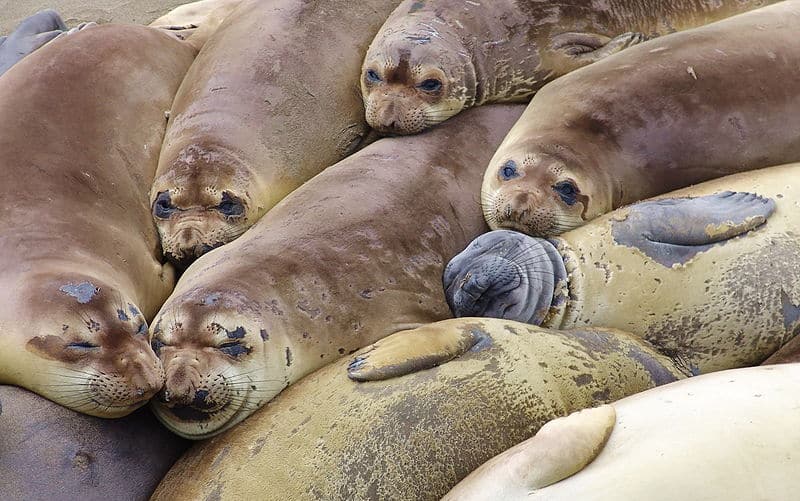
Female elephant seals are much smaller than males and more social.
The short front flippers and hind flippers of this seal all have a specific purpose. Its front flippers help these seals to change direction when swimming while their webbed hind flippers move them forward through the ocean. When on land, these seals use their front flippers to rock themselves forward while dragging their hind flippers. It’s not hard to see why this seal prefers to be in the water!
Elephant seals are both solitary and social. When they are swimming in the ocean they are solitary. But, when they return to the land and join the rookery during breeding season they become social. A group of seals has many names including a herd, a bob, a colony, or a harem (females only).
Elephant seals are extremely territorial and can be very aggressive when defending their area of shore. A male seal gathers 40 to 50 female seals, or a harem, to stay within his territory. If one male tries to invade another’s territory, it can result in a bloody, violent fight as the territory is defended. It’s also very noisy. Male seals make deep, echoing sounds similar to drum beats as they fight with another male.
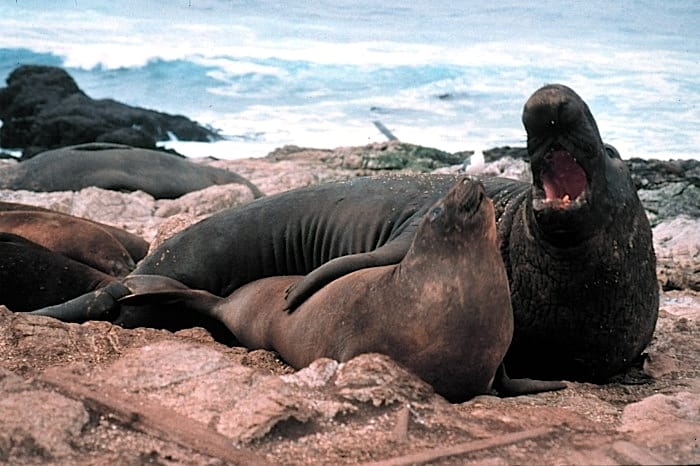
Habitat
Northern elephant seals live in the North Pacific near Baja California, Mexico to the Aleutian Islands and the Gulf of Alaska. Southern elephant seals live in the sub-Antarctic and Antarctic waters.
These seals migrate to the ocean spending several months hunting for food. Marine biologists have found male seals follow a similar path as they migrate while female seals choose different routes to travel in the ocean. In mid-December, these seals return to land to breed, heading back out to the ocean at the end of March.
The thick layers of fat on these seals keep them warm as they swim through the frigid waters of the ocean. Plus, they have specially developed lungs that deflate as they dive deeply into the ocean for food and refill with air when they resurface.
Diet
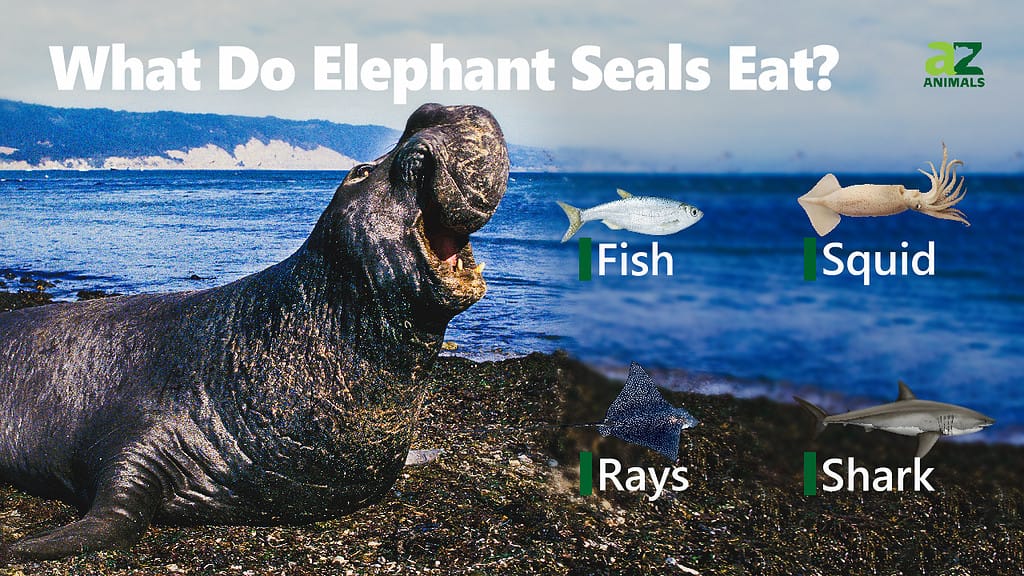
What do elephant seals eat? Squids, rays, penguins, small sharks, crabs, and fish are all on the menu of these carnivores. During their nine months or so spent in the ocean, they are rarely seen at the surface of the water. They are either swimming just beneath the surface or diving into the depths in search of food. These seals add a lot of fat to their bodies during these months. Once the mating season begins, they begin a fasting period (they don’t eat).
Predators and Threats
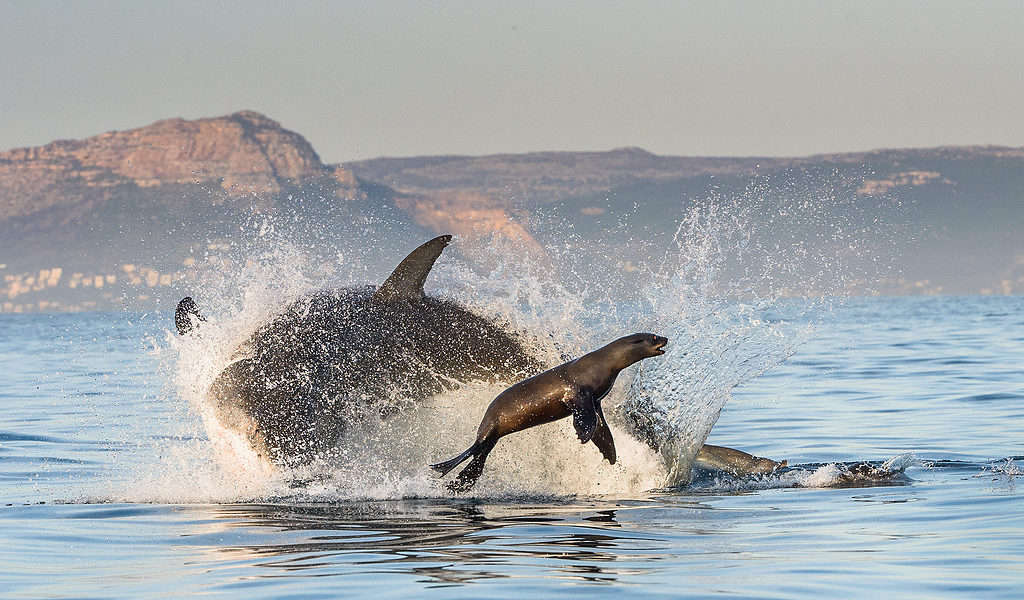
Great white sharks prey on elephant seals.
©iStock.com/USO
Great white sharks and killer whales are two predators of these seals. They are so large, they have very few predators in the ocean.
However, the fishing activities of humans can be a threat to these seals. They sometimes become tangled in large commercial fishing nets leading to great injury or death. Also, these seals are sometimes hit by large ships and other ocean vessels which can result in their death.
Environmental events, such as hurricanes and tropical storms, can reduce the population of elephant seals. Seal pups that are not yet strong swimmers can be swept up and killed in these weather events.
At one time, these seals were hunted by poachers for the oil in their blubber. Now, they have legal protection against poaching activities. The conservation status of elephant seals, according to the International Union for the Conservation of Nature (IUCN), is the least concern.
Reproduction, Babies, and Lifespan
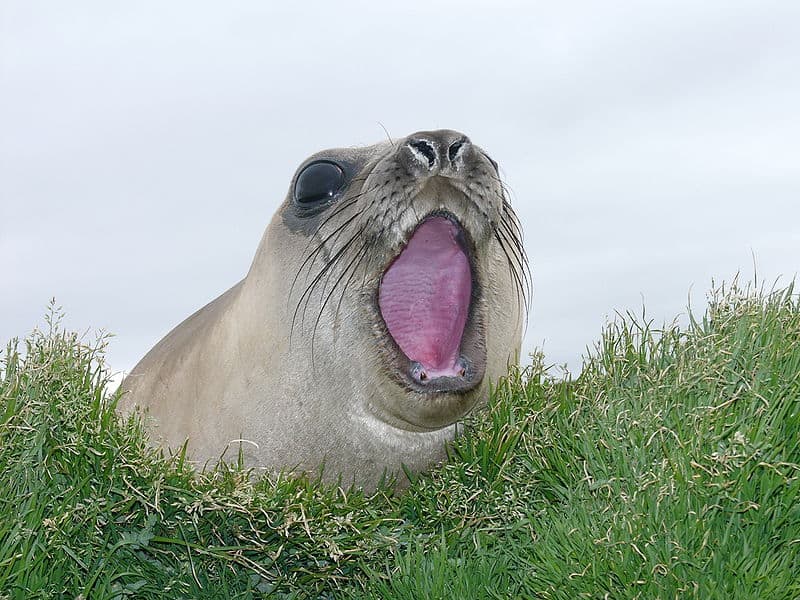
Female elephant seals live in the ocean while pregnant and come to shore to give birth and care for their baby for one month.
Mating season begins in December for elephant seals. They come out of the ocean and settle onshore. The male seal elephants also called bulls, arrive at the rookery before the females. Male seals fight with one another for territory and dominance. A male seal raises the top half of its body, sometimes allowing it to stand six feet tall. Two male seals hit each other with their elephant-like noses, bite, and push each other until one gives up or is so injured it can’t continue. This is a noisy, dangerous encounter!
Once the dominant male seals establish their territory, the female seals arrive from the ocean. A male seal has 40 to 50 females in his territory. A group of females is called a harem. The male mates with most of the females in the harem.
The gestation period of a female elephant seal is 11 months. Once a female seal becomes pregnant, she returns to the ocean. She’ll later come back to shore and give live birth to one baby, also called a pup. A newborn seal pup weighs around 75 pounds and is covered in black fur. The pup is able to see, hear, and move right from birth.
A mother seal nurses her pup for one month, then it begins to eat solid food. The mother leaves her pup after just one month and breeds with a male before leaving the rookery to return to the ocean. A month-old elephant seal pup must learn and practice its swimming and hunting skills on its own.
The average lifespan of a northern elephant seal is nine years, while the lifespan of a southern elephant seal ranges from 20 to 22 years. Female seals usually live longer than male seals because male seals must fight for territory and sometimes receive life-shortening injuries. These seals are also vulnerable to a variety of skin diseases.
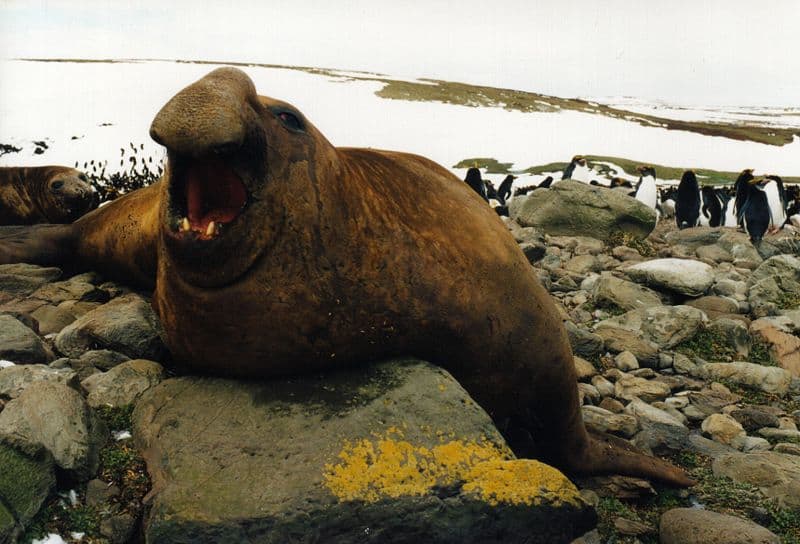
Southern elephant seal populations are three times that of the northern species.
©B.navez / CC BY-SA 4.0 – License
Population
The population of northern elephant seals is believed to be around 127,000. There are 26,000 living near the Mexican coast, while the remainder lives off the coast of California. There are approximately 650,000 southern elephant seals in existence.
The population of these seals is either stable or increasing. That’s good news, considering they almost became extinct in the 19th century due to poaching activity. Today, the conservation status of both species is the least concern.
Elephant Seal FAQs (Frequently Asked Questions)
How big is an elephant seal?
A male elephant seal from the north can be as large as 13 feet long and weigh 4,400 pounds. A male southern elephant seal grows to about 16 feet and can weigh up to 11,000 pounds.
A female elephant seal living in the north is about 10 feet long and weighs around 1,300 pounds. A female elephant seal living in the Antarctic region can be as long as 10 feet and weigh around 2,000 pounds.
What do elephant seals eat - are they carnivores, herbivores, or omnivores?
Elephant seals are carnivores – eating crabs, rays, small sharks, octopus, fish, and squid. An elephant seal pup that’s just learning to hunt eats smaller fish and crabs to start.
What is the difference between an elephant seal and a walrus? Which is bigger?
If you’ve put photos of an elephant seal and a walrus side by side, you know they are similar in appearance. The main obvious difference is that a walrus has tusks, however, they also differ in size. Elephant seals are bigger than even the largest male walrus. A male Pacific walrus weighs around 1,700 pounds while a male Atlantic walrus weighs around 2,000 pounds. While male elephant seals are often at least double that.
The differences between a walrus and an elephant seal include size, habitat, and reproductive differences. Elephant seals far outweigh walruses, and walruses spend more time taking care of their young.
Where do elephant seals live?
The two species of elephant seal live in different places. The northern elephant seal lives near Baja California, toward Mexico and the Aleutian Islands as well as in the Gulf of Alaska. Southern elephant seals live in Antarctic and sub-Antarctic waters. They are in the ocean for nine months a year and on land in a rookery for about three months.
Are elephant seals dangerous?
Elephant seals are not aggressive unless they are defending their territory or young. They would rather not encounter humans.
If you ever see an elephant seal, especially if it’s on land, it’s best to remain far away from it so it doesn’t consider you a threat.
What Kingdom do Elephant Seals belong to?
Elephant Seals belong to the Kingdom Animalia.
What phylum do Elephant Seals belong to?
Elephant Seals belong to the phylum Chordata.
What class do Elephant Seals belong to?
Elephant Seals belong to the class Mammalia.
What family do Elephant Seals belong to?
Elephant Seals belong to the family Phocidae.
What order do Elephant Seals belong to?
Elephant Seals belong to the order Carnivora.
What genus do Elephant Seals belong to?
Elephant Seals belong to the genus Mirounga.
What type of covering do Elephant Seals have?
Elephant Seals are covered in Fur.
What are some distinguishing features of Elephant Seals?
Elephant Seals have long trunk-like noses and large bodies.
What are some predators of Elephant Seals?
Predators of Elephant Seals include human, sharks, and killer whales.
What is the average litter size for a Elephant Seal?
The average litter size for a Elephant Seal is 1.
What is an interesting fact about Elephant Seals?
Elephant Seals are the largest species of seal in the world!
What is the scientific name for the Elephant Seal?
The scientific name for the Elephant Seal is Mirounga.
What is the lifespan of an Elephant Seal?
Elephant Seals can live for 18 to 22 years.
Thank you for reading! Have some feedback for us? Contact the AZ Animals editorial team.
Sources
- David Burnie, Dorling Kindersley (2011) Animal, The Definitive Visual Guide To The World's Wildlife
- Tom Jackson, Lorenz Books (2007) The World Encyclopedia Of Animals
- David Burnie, Kingfisher (2011) The Kingfisher Animal Encyclopedia
- Richard Mackay, University of California Press (2009) The Atlas Of Endangered Species
- David Burnie, Dorling Kindersley (2008) Illustrated Encyclopedia Of Animals
- Dorling Kindersley (2006) Dorling Kindersley Encyclopedia Of Animals
- David W. Macdonald, Oxford University Press (2010) The Encyclopedia Of Mammals

